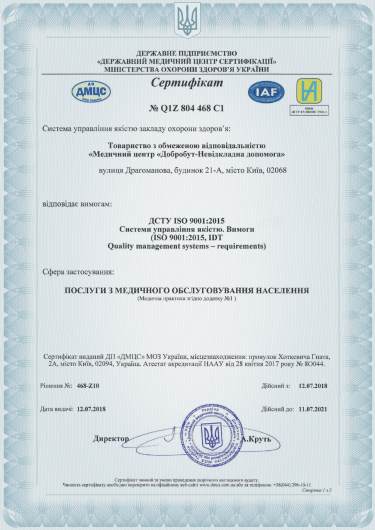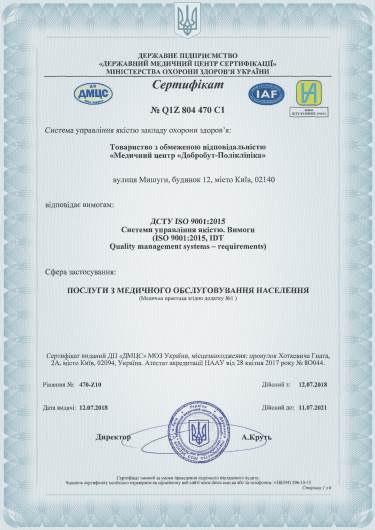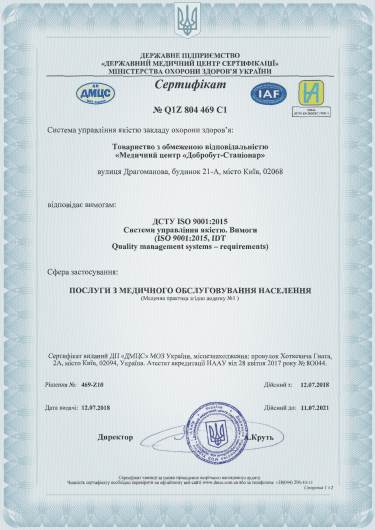Installing ports for chemotherapy
Installing ports for chemotherapy
The port system is an alternative to a stationary catheter that is implanted under the skin to provide painless and long-term access to the central blood flow. The installation of a subcutaneous port system, instead of permanent peripheral venous catheters, is the standard for modern medical institutions in Ukraine when conducting chemotherapy and has important advantages for patients and their families.
Advantages of the subcutaneous port system:
Installing a chemotherapy port is a step forward in improving the quality of life. Patients with a port system do not feel any inconvenience both during the procedure and in everyday life, it is also invisible under the skin. Chemotherapy drugs are quick and easy to administer. Another advantage of using the port system is minimal damage to the veins during repeated and regular manipulations. The next advantage is the duration of use (from 3 to 5 years) without the need for replacement and emergency removal if necessary, which is important for the treatment of patients with oncology. The cost of installing a port for chemotherapy in our clinic, which is located in the city of Kyiv, largely depends on the manufacturer's company, the length of hospital stay, and anesthesia.
What is the chemotherapy port made of?
The infusion port is in two parts. The first component is a subcutaneous titanium reservoir of a rounded shape, about 4 cm in diameter and about 1 cm thick, internally coated with a bioinert polymer. The top of the reservoir on which the membrane is covered with multi-layer silicone. The membrane is pierced with a Huber needle and drugs are injected. The second is a flexible catheter in the form of a thin tube, one end of which is implanted into the jugular vein (less often, into an artery), and the other is attached to the reservoir.
How is the port implanted?
The intravenous port for chemotherapy is implanted in an aseptic operating room under X-ray control, the operation is painless and is performed under intravenous or local anesthesia. The location and method of the port location are established depending on the general condition of the patient and the planned type of treatment. To do this, the doctor conducts a preliminary examination and analyzes a clinical blood test performed no later than 10 days before the date of admission. Typically, the port is implanted in the subclavian region. To do this, the patient's skin is treated with an antiseptic agent at the site where the port will be implanted, then the surgeon inserts a catheter into the superior vena cava, through the subclavian or internal jugular vein, after which a small incision is made and the port system is installed. The duration of the procedure is about 30-45 minutes.
Feelings after the procedure:
The patient may experience some discomfort at the incision sites and in the area where the port passes under the skin. The pain usually subsides within 24 to 48 hours. In most cases, patients do not need to take prescription pain relievers.
The process of introducing chemotherapy drugs through the port system
Before starting the manipulation, the nurse examines the skin around the port for inflammation (edema, hyperemia, rash, tenderness to palpation) and the exact localization of the silicone membrane. Next, the nurse fixes the palpable port between the index and thumb of the left hand. After treating the skin with antiseptic agents, the needle is vertically inserted into the silicone membrane until it stops in the back wall of the port chamber. Next, the nurse pulls the syringe plunger towards herself to check if there is a reverse flow of blood. If there is no reverse flow of blood, which indicates obstruction, then 20 ml of NaCl solution is gradually introduced. In cases where there is no edema around the catheter, and the introduction is painless, all 20 ml of NaCl solution is injected into the catheter, then the patency of the port is established. The Huber needle is secured with a sterile fixation bandage. For long-term infusions, the dressing is changed. The administration of drugs is carried out under the supervision of medical personnel. With a properly installed port system, drug administration should be painless. Otherwise, you need to inform the nurse, she will stop the procedure and call the attending physician. After completion of the infusion of drugs, the port system is flushed with physiological and then heparin solution, to avoid the formation of blood clots in the catheter.
Contraindications to implantation of permanent access systems (ports):
- patients with uncontrolled hemostasis disorders;
- acute thrombosis of the great veins;
- a relative contraindication can be considered an extremely serious condition of the patient, multiple organ failure;
- obstruction of a vein as a result of a previous thrombosis;
- tumors of the mediastinum;
- known allergic reactions to the port material;
- inflammatory processes and subsequent irradiation in the area of the proposed installation.
Inconvenience when installing a chemotherapy port?
The rhythm of life of patients who have been supplied with a port for chemotherapy is not disturbed. They can freely engage in daily work activities, play sports, etc. If we compare the traditional catheter and the port system, the advantage of the port is the absence of discomfort and inflammation of the skin at the implantation site, it is hidden under the skin and is not exposed to environmental factors. It is also worth noting that the port is felt only by touch and is not visible to the naked eye. The age of a person is not a contraindication for the installation of a port system.
The advantages of carrying out the service with us:
- In the practice of the Dobrobut clinic in Kyiv, ports of only trusted manufacturers with a high reputation are used
- Implantation is carried out by specially trained high-class specialists (anesthesiologist, surgeon-oncologist)
- Installation takes place in the operating room without hospitalization, in the order of appointment (implantation is possible on the day of treatment)
- The port is installed under X-ray control, which minimizes the risk of complications for the patient.
How to sign up?
You can make an appointment for a preliminary examination, get acquainted with the approximate prices for installing a port for chemotherapy on our website https://www.dobrobut.com/ or using the 24-hour contact center, whose contacts are listed on the clinic's website.
Bibliography
- Лучевая диагностика, лучевая терапия. Полностью имплантируемые инфузионные системы центрального венозного доступа (порты) / А. Г. Югринов, И. Климнюк, Е. М. Новак [идр.] // Клиническая онкология.- К., 2011.-No 2.
- Николаев А. В. Пункция икатетеризация подключичной вены по методике Сельдингера / А. В. Николаев // Топографическая анатомия и оперативная хирургия.- М., 2007.-С. 14-24.
- Центральные венозные порты - инфузионная терапия в амбулаторных условиях / М. Ю. Шерстнев [идр.] // СТАЦИОНАРОЗАМЕЩАЮЩИЕ технологии. Амбулаторная хирургия.- 2013-No 1.-С.3-6.
- Центральные венозные порты - продолженная инфузионная терапия / М. Ю. Шерстнев [и др.] // Клиническая больница.-2013-No 4.- С.60-63.
- RowalskiC. M. Migration of central venous catheters: implicationsforinitial catheter timpositoniry /C.M.Rowalski, 1. А. Кaufman, S. M. Rivitz // I. Vasc. Interv. Radiolology. - 1997. -No 8.-Р. 443-447.
- Tubes, Lines, Ports, and Catheters Used in Cancer Treatment. Published online, March 27, 2020.
Our advantages
Our oncological services
We are located at
ISO certificates



Accreditation certificates



Medical practice licenses








%402x.png)
%402x.png)
